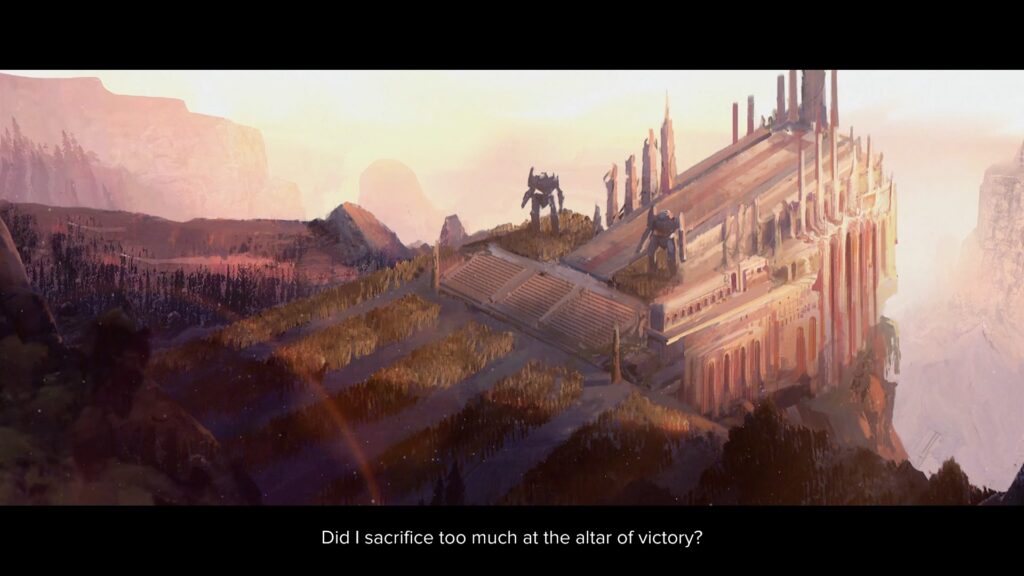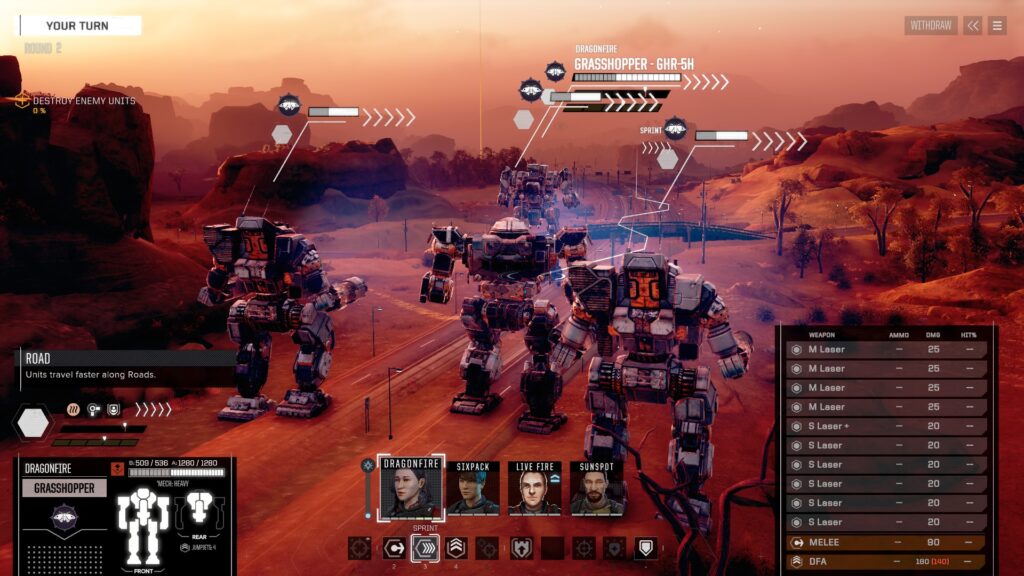
Me and the squad are going to wreck someone’s day.
Game Name: Battletech (2018)
Developer: Harebrained Schemes (Shadowrun, Golem Arcana, Necropolis)
Platform: Windows, OS X, Linux (reviewed on Windows, some screenshots from DLC)
Categories: Tabletop > Video Game Translation, SciFi Feudalism, Space Opera, Pirates, Mech Customization, Autocannons, Lasers, Pyrotechnics, Salvage, Turn-Based, Dot Grid, Pilot Advancement and Skills, Budget Balancing, Risk/Reward, Open-Ended Progression, Story/Career/Multiplayer Modes, Variable Difficulty, Kickstarted, Beautiful Concept Art, Acceptable 3D Visuals, Legendary Soundtrack, Limited Maps, Attempts at Mission Variety, Power Creep, Glitchy Release, Long Loads, Sluggish Pace, Dumb AI, Jordan Weisman
May Appeal To: my fellow lancemates, mech commanders, mercenary managers, battlebot designers, number crunchers, statisticians, gamblers, and anyone else who thinks that a millennia of technology and weeks of FTL travel should always culminate in a bipedal tank punching another in the face over a border dispute.
May Repulse: the antsy, the unfocused, the instant gratification demanders, and space drama-phobic invulni-gamers disillusioned that this plays like MWO or Mechwarrior 5. Forewarning: this game is a slow burn and skirting the edge of being poor and small decisions paying out in dividends is the primary attaction of investing time in it.
Comparable To: Starcraft II’s HQ navigation and specialist subscreens, Crusader King II’s random events, Front Mission’s melding of mech customization and battle execution, a turn-based Mech Commander at reduced scale, a less faithful and broader-appeal version of MegaMek. This game has a soundtrack to surpass even Mechwarrior 2, has almost the same number of mechs as MW5 (50+) and half of MWO’s (100). Lastly, Harebrained Scheme’s Battletech is so analagous to the pacing, cinematography, and design of XCOM: Enemy Unknown that I have little doubt the initial game pitch included a direct reference to that title by name. (Even the overlapping dates for progress results and R&D is similar though Battletech retains the robust mech customization -with hardpoints- from MWO/MW4.)
Learning Curve: You’ll be picking up new tactics, design philosophies, and meta-approaches to ship improvements or budget balancing for 10 or more hours.
Game Length: About 55 hours per Campaign or Career playthrough if not rushing.
Difficulty: Variable, but casual gamers may be ill-prepared for Career mode or Multiplayer.
Mastery: Maybe you can achieve a Kerensky ranking because I sure as hell didn’t!
There are different skillsets involved here: mech design, lucrative profits, project management levels of task administration, and tactical command. Any one of these is a challenge unto itself but you’ll need at least two to excel! There’s plenty of room for improvement so curate your own goals and re-evaluate to set your session’s ambitions.
(Tabletop works a bit like this too since it has a million options, scopes, and rulesets.)
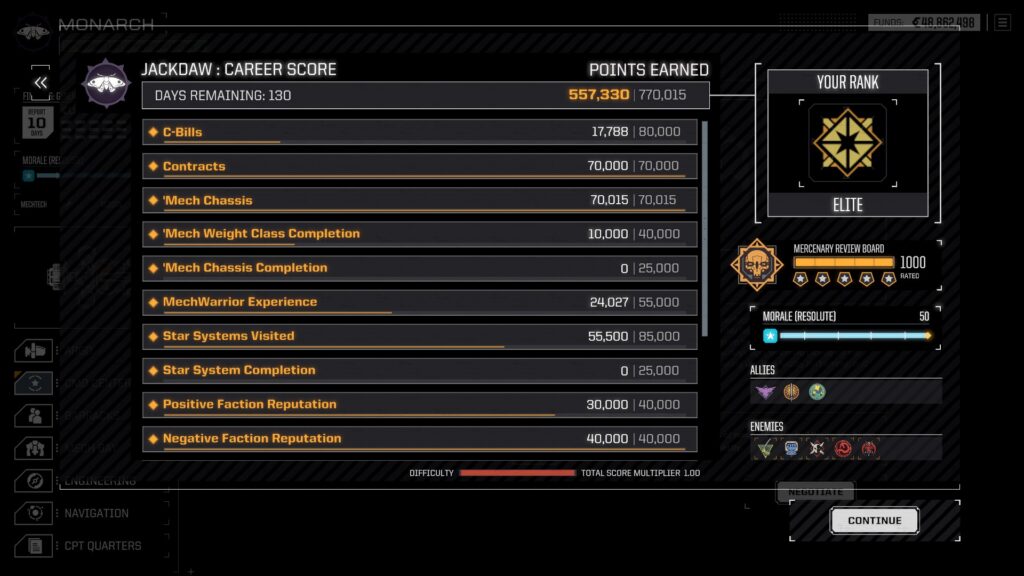
Kerensky, you magnificent bastard. I just can’t attain your rank.
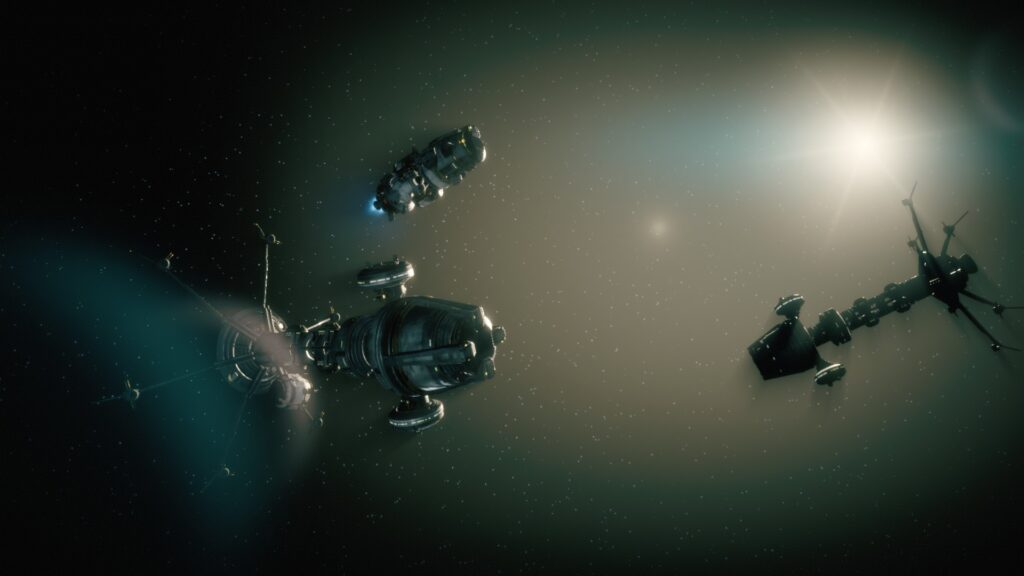
I implicitly trust the centuries-old teleporters that get used weekly and few know how to build.
Story: It’s rare that gaming properties maintain a core fan presence for 35 years and fewer still have their world propelled through a millennia with the canonical release of 100+ novels and a couple hundred different sourcebooks aimed at supplying fuel for the role-playing and wargaming communities! I suppose I’m just trying to draw awe and consideration for the endlessly mysterious depths of the Battletech lore – one that’s vibrant and alive and intimidating and primarily explored through the eyes of hapless mercenary crews across many kitchen tables this very second.
HBS’s Battletech game is brainchild to Jordan Weisman and eponymous to his original creation in 1984, lending credence to this entry’s validity and testament to the tone with which he views the struggles of coordinators and princes, archons and chancellors in vying to conquer their neighbors in a mindless extension of eternal war underfoot of “giant stompy robots”.
The Star League, once united under tentative constraints and the threat of physical might, crumbled after the extermination of House Cameron left a power vacuum. Unbound, the majority of the Star League Defense Force chose not to be a weapon wielded by the feuding houses of Davion, Liao, Kurita, Marik, and Steiner, instead conspiring to self exile from the Inner Sphere altogether. From this event sparked predictable repercussions: the large and powerful houses flooded previous Cameron holdings, seized massive factories of war materiel, and sought to obliterate their opponents’ advantages through weapons of mass destruction. Drunk on greed and cyclical acts of revenge, they quite literally bombed themselves until the technological advancements of the previous era became untenable to produce and the great minds of the present became utterly lost to assassination plots.
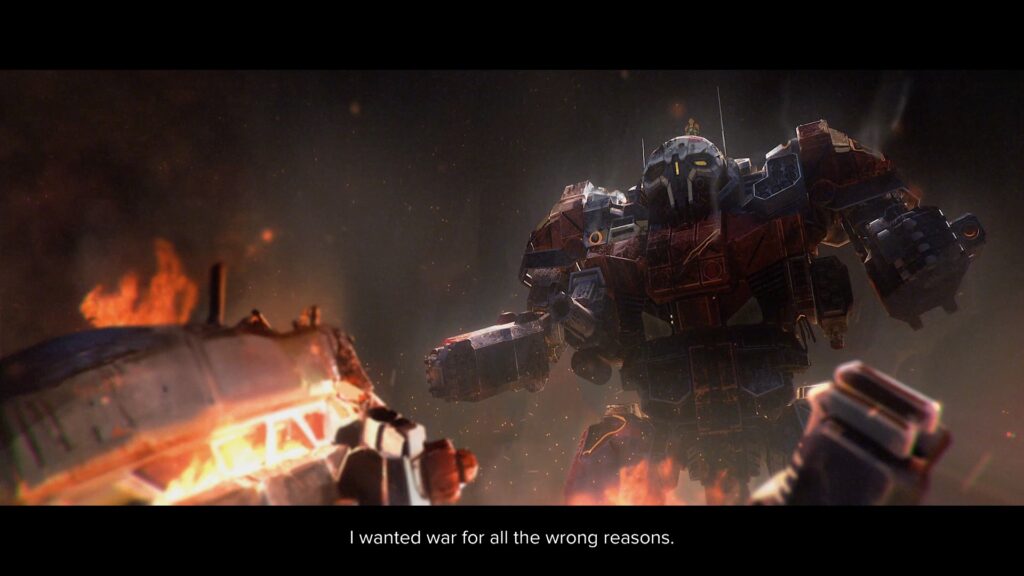
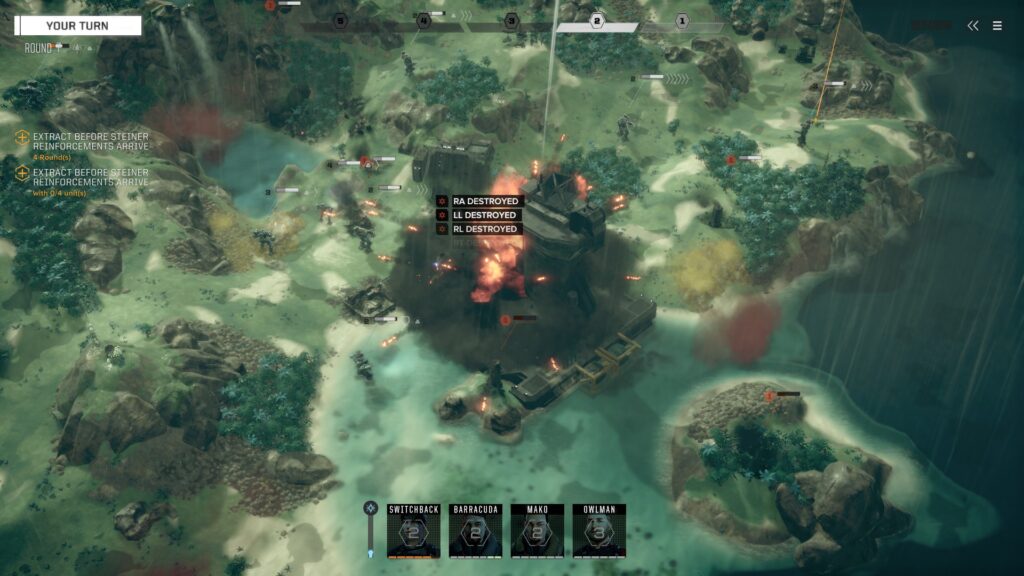
Pictured here: An in-game orbital strike. Some lessons are harder to learn than others.
Centuries pass. Gone are the great warship fleets. Gone are the massive hundred-unit deployments of battlemechs. Gone are the advanced techniques of military manufacturing and the secrets of certain weapon systems. In its place are the sanctioned protections of interstellar communications centers, the protection of space-folding jumpships, and the proliferation of largely-symbolic combat rituals involving scant forces in the interest of preserving civilian life and property. Built to last, battlemechs become heirlooms that are passed down throughout generations, creating a new class of warrior that plays a willing cat’s paw for the nations that need them.
For those mechwarriors free of faction loyalties and a pocketful of luck, the life of a mercenary can be a profitable venture despite the lack of solidarity and resources of a standing military – leading to many adventures in morally ambiguous contracts of wetworks, false flag operations, and pirate entanglements. The incessant enticement of self-employment, the next lucrative windfall, or the fabled stories of lost-tech caches beckon many mech-endowed organizations to risk life and limb as they wander the stars and negotiate their services to the available bidders.
Though the raging fires of mutual destruction have subsided, the great houses remain grappled in a stalemate as they fan the eternal embers of localized brush fires known as the “Third Succession War” in the year 3025. The periphery nations -pioneers of the stars and skirting the edges of known space- originally reveled in the collapse of the Star League and stole the opportunity to be largely ignored by the great houses as they themselves grew and adapted to life on the fringes of civilization and technology, while their own border conflicts began to blossom. The Aurigan Coalition (a previously unmentioned power) is at a crossroads of its nascent development. Finding herself as a target of internal strife and a proxy for feuding neighbors, the Coalition’s heir-designate Lady Arano propositions your fledgeling mercenary group with an earnest plea and the promise of recompense.
Is yours the type of company that fights for altruism or one that fleeces their clients for personal gain – or a bit of both? Do you have the managerial acumen, tactics, and holistically good fortune to succeed at that undertaking?
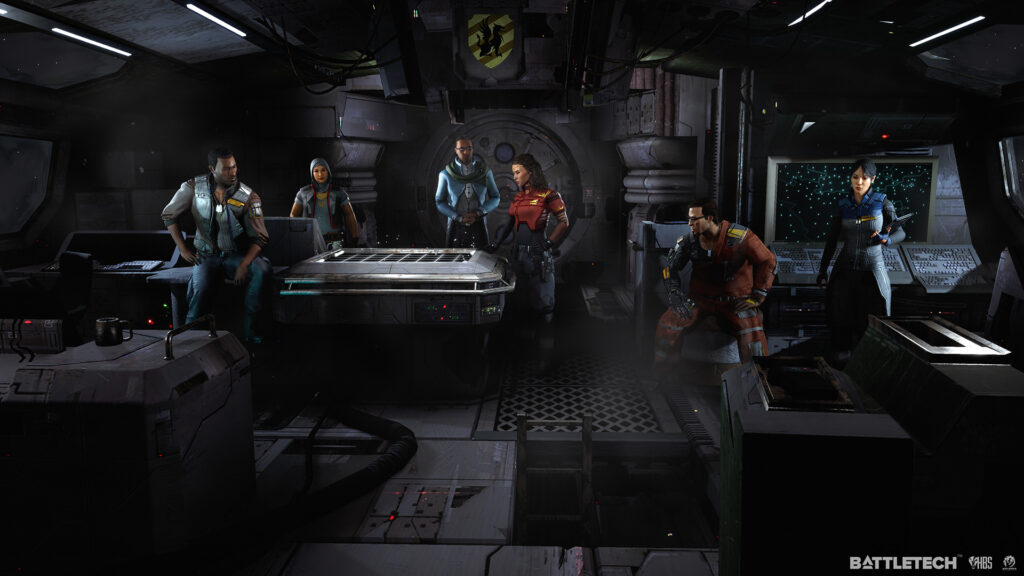
What, you guys didn’t like my Kabuki theater? I worked really hard on it!
Presentation: I’ve never seen a better pitch for the Battletech universe than the dramatic, two minute intro upon startup. And as far as I’m concerned, this soundtrack proves to be the ultimate resume’ for Jon Everist and one of the key guiding principles for the game’s aesthetic, which represents the survivors of unlimited warfare as being wistful and jaded, morose and weary. Depression or undue bleakness would have been an easy trap to fall into, but the somber imagery with splashes of color during your travels appears to take queues from the brilliant orchestral scores and leisurely guitar musings during load screens. It’s a pure fuckin’ shame the bad-to-acceptable voicework of your lancemates simply doesn’t pay reverence to the otherwise stellar audio design. (At least you can edit their obnoxiously forced attempts at accents and even the distractingly fugly portraits.)
Initially a Kickstarter project, HBS’s Battletech communicates a sense it had small ambitions and built upon them as time and funds went on. Although most elements are attractive, this trait stands out to me (mostly because of the amount of hours played): procedurally-generated portraits, painterly KS backer portraits, hand-arranged campaign missions, bland terrain configurations that appear procedurally arranged but repeat, minimal spoken dialogue or conversational options with your staff leaders, almost silent interviews with prospective contract-holders outside the main campaign, excellent sound effect arrangements that pull you into the action, blocky low-poly licenses of the MWO models complimented by appropriate textures, low-end water effects, mid-tier weapon effects, high-end atmospherics, incredible color palette selections for the varied environs, painterly static “events” screens, and plenty of gorgeous cinematics that are animated like flowing concept art. The DLC also adds new biomes, mechs, missions, and canonical characters that flesh out the stable. This mixed bag of assets, though economical in places, is actually orchestrated quite well and has a net gain despite lesser elements.
I only fault it for repetition as an extension of the redundancy of the gameplay.
(Aside from the loathsome pilots, which should be redone from scratch.)
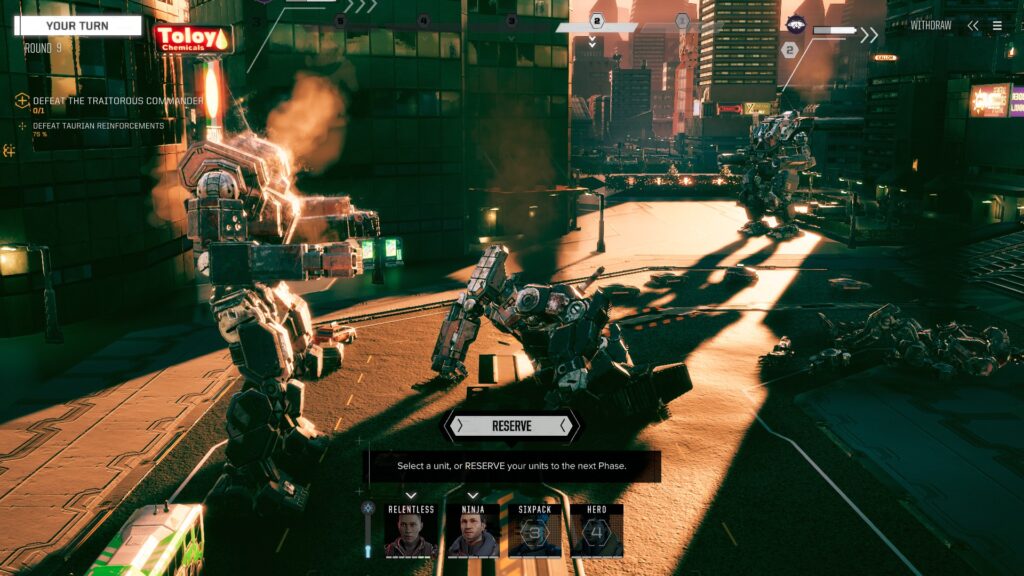
If the mechwarriors didn’t talk like a redneck with a mouth full of marbles or a third string extra from The Sopranos, this would be a dramatic sequence.
Though some might consider my criticisms minor, the UI rubbed me the wrong way in defiance of it checking the boxes for functionality. Weird design choices persist like lengthy mission loading screens which A) look frozen B) have no interesting pictures, tips, or lore C) don’t auto-start D) give no audio indication when the Begin Mission button finally loads. Similarly, I have to confirm mission termination by hitting “Continue” through every line of character dialogue before hitting “Done” and then “Continue” once more after MISSION SUCCESS is displayed. The amount of clicks belie the simplicty of the rectangular, grayscale, utilitarian UI scheme though interacting with it exacerbates the severe pacing issues regarding the most numerous delays I’ve seen before in basic navigation.
Mech combat is obviously the reason we’re here though – and the action is very satisfying. Enhanced in no small part by the throaty bass of 80 tons of metal reverberating in mock rhythm to the percussive drums and epic men’s choir, the player becomes invested and connected to the action. There’s some lizard-brain impulse mapping at work here with the build-up of tensions from the precarious musical scores and scenario being released with a few radio squawks, a smattering of UI trills, and the earth-shattering ‘booms’ as the dramatic cinematography tries to keep up with a swarm of erratic missiles and rage beams erupting forth to send armor plating flying and rivulets of magma sloughing off. Something that could dampen your spirits about engagements is the general sluggishness of the war machines as they jockey for position (a “fast-travel” button exists which curtails the acceleration/deceleration cycles – causing the beasts to flit across the screen).
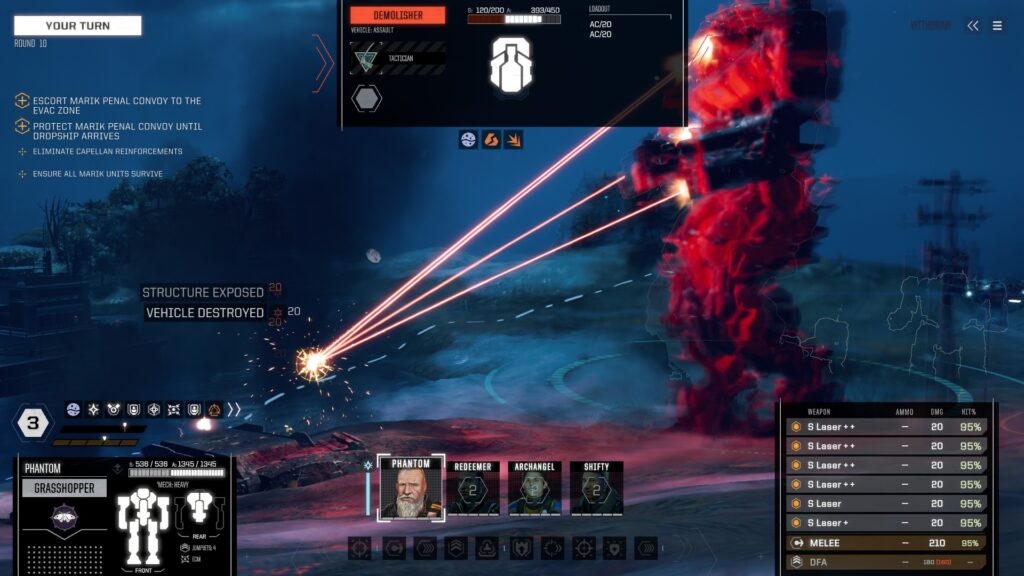
“This isn’t even my final form!”
Unique Features: The XCOM battle flow absolutely fits here despite being definitively not unique to this game. Melee combat amid massive behemoths is rare (Into The Breach and Mechwarrior Tactics both had it but they’re an isometric puzzle game and vaporware, respectively). While lifting core elements from Mech Commander and Mechwarrior’s unit customization, the mercenary narrative with an augmented tabletop experience is actually the first of its kind for the series – but the brilliant Front Mission series beats it to the punch!
Gameplay: The player starts a career playthrough as a mechwarrior, tactical commander, and CEO of a small mercenary group that employs a lance of piloted mechs, a dropship shuttle, and a specialized HQ with its own K-F drive for interstellar travel. Under the advisement of free-spoken senior staffing, the player chooses name and the iconography/colors for the group, picks planetoid destinations, selects from available contracts (based on difficulty, reputation, affiliation, and payouts), pursues any optional mission branches, hires supplemental pilots, guides the team’s raw experience into skill points, buys/sells military equipment, prioritizes ship upgrades for task efficiency or to boost morale, extensively customizes the growing stable of mechs, and controls the lance’s actions/abilities in coordinated turn-based combat.
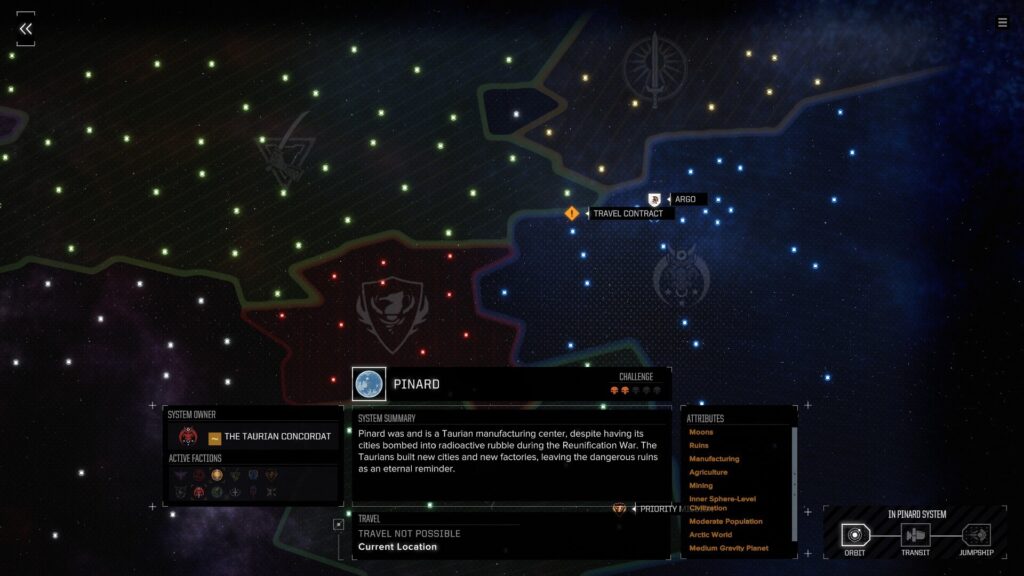
Pay attention to the planetary attributes. I’m sure they’ll be useful to someone some day….
Having relegated the experience to the immediate area surrounding the Aurigan uprising, the game’s bounding box encompasses the rimward periphery with the corners of bigger nations peeking in (FedSuns, FWL, Taurians, Canopus, and Capellan Confederation). Lyran and Kuritan “guest stars” stop by to offer specialized missions outside their normal territory and the big wigs of legendary merc companies, especially, have referenced cameos or fight alongside the group in rare “Flashpoint” missions. Navigating the map to a new location to scout fresh contracts takes time, even weeks, perfect for scheduling mech refits and shelling cash for jumpship habitation pods and other upgrades to keep your staff happy and productive.
Crewmates don’t always get along and having a zero G pool and arcade (not to mention an extensive medbay and automated repair facilities) are options to help extinguish the surfeit of random events that freeze time and require your immediate attention before proceeding. As an underrated pleasure of being in charge and setting policy, there is plenty of variety to the scenarios which break up the combat cycle with some out-of-mech conflict to resolve. Ultimately, deciding the fate of a crew intent on skinny dipping and tinkering with weapons on the company dime are just distractions to the main event.

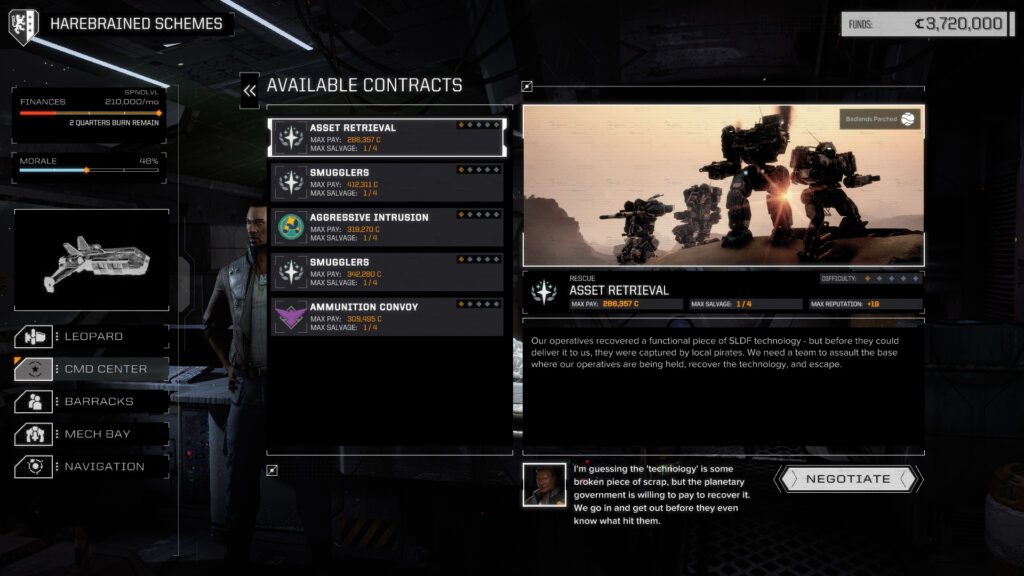
Pirates are “local governments” with fewer scruples, right?
Through the artifice of morally ambiguous benefactors, the mercenaries keep the engines charged, electricity flowing, and balance books out of the red through some form of risk or sacrifice. Sometimes health, wealth, and fame come at the expense of unlucky pilots, at the chance of destroying a particularly rare piece of equipment, or compromising morals by conducting assassinations, illegal deployments, and the dilemma of backstabbing your current employer to either collect a boon for yourself or to sweeten relations with a future prospect. Grease the right palms and burn the right bridges and your crew becomes bonafide pirates with special access to black market goods that compete with many of the Inner Sphere storehouses!
Battle plays out as an augmented version of tabletop, with a 5 phase sequence bar allowing for lighter assets the ‘first refusal’ to either move or await heavier units to take their turn (the attack and movement phases are combined and allow for immediate strikes). With sound judgement, it’s entirely possible to conduct a clean sweep of enemy assets without absorbing anything beyond armor repairs, which are free. In all likelihood though, mechs will be trading morale for bonus abilities, trading speed for tonnage, equipment weight for range, heat for weapons fire, defensive terrain for attack angle, back shots for melee hits, and self-damage for devastating Attacks From Above! Where you place specialized equipment matters since limbs and torsos become shredded during protracted combat and must be scrapped. After battle, you reap the fruits of your labor since salvage rights negotiated during contracts allow for a vulture’s scrutiny in choosing pieces of your foes equipment to incorporate into your own – including exclusive chassis variants, which Yang can assemble into a fully-functioning mech with enough parts.
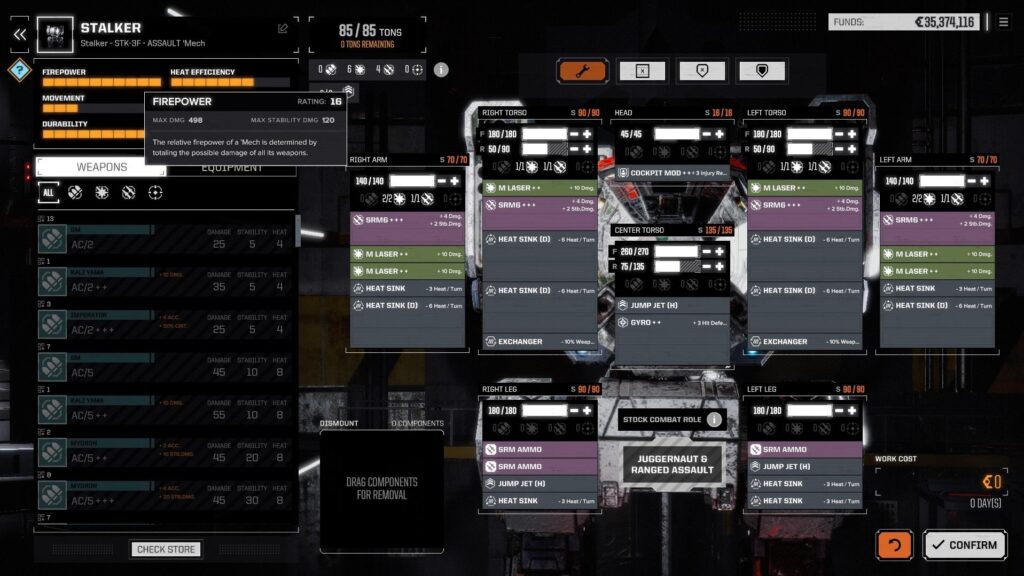
The BadYear Blimp might walk funny, but I wouldn’t mess with a bipedal dirigible.
Multiplayer skirmishes do exist though most commanders will find themselves matching wits against the lackluster AI, whom oftentimes avoids firing on the first turn, rarely flees, and marches their units into a killbox with disregard for their own safety. Despite suddenly spawning within my radar 5% of the time (with Rangefinding abilities), I never felt threatened unless massively outnumbered or when I’d fallen into disfavor with RNGesus and had a cockpit explode. This AI issue extends to APC escort missions in which the rear unit requires a babysitter in order to “remember” to move at all. (I’ve had several payouts cut in half due to the vehicle lance awaiting a straggler and succumbing to enemy fire.)
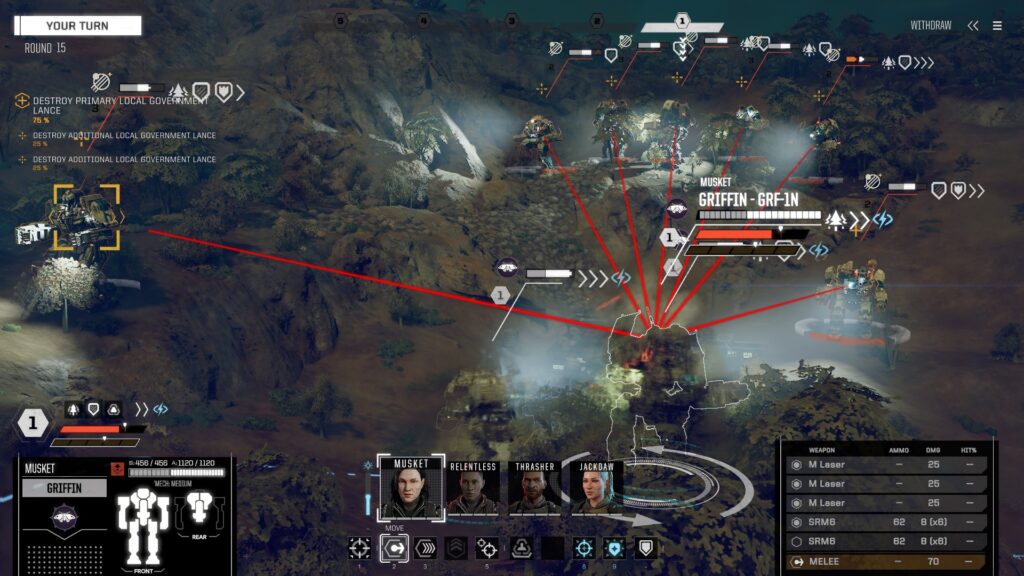
Aw c’mon fellas, I was just exaggerating about the ‘dumb AI’ thing….
Additional Comments: Let’s just blitz through some differences from tabletop:
- Hexes aren’t present but the “dots” on the map function similarly, including arcs.
- Various weapons have tweaked damage values, especially autocannons!
- Jumping and movement doesn’t affect shooting numbers, only the defensive mod.
- Water has no chance of breaching compartments.
- The more limbs you destroy, the greater chances at salvaging mechs.
- You cannot field a partial/incomplete design like when it’s missing a limb.
(This is troublesome for consecutive deployments and no backups.) - Armor and ammo are free.
- Only topography can block line of sight. Terrain gives a damage reduction bonus.
- Melee attacks don’t consider “levels” and don’t have punch or kick tables.
- “Support” weapons like Small Lasers and Flamers fire during melee attacks.
- Movement isn’t granular enough for circumnavigating an opponent and punching.
- You can’t sell equipment for the prices you pay for it, including fully formed mechs.
- ECM in one of the DLCs is an invisibility bubble. (Yes, it’s overpowered.)
- Light mechs are allowed to move ahead of heavy mechs or to delay their phase.
- Movement/Weapons/Physicals/Heat are resolved simultaneously for each mech.
- Anachronistic equipment and weapons appear and are less rare than expected.
- The Bullshark, Argo, and Aurigan Coalition are canonized.
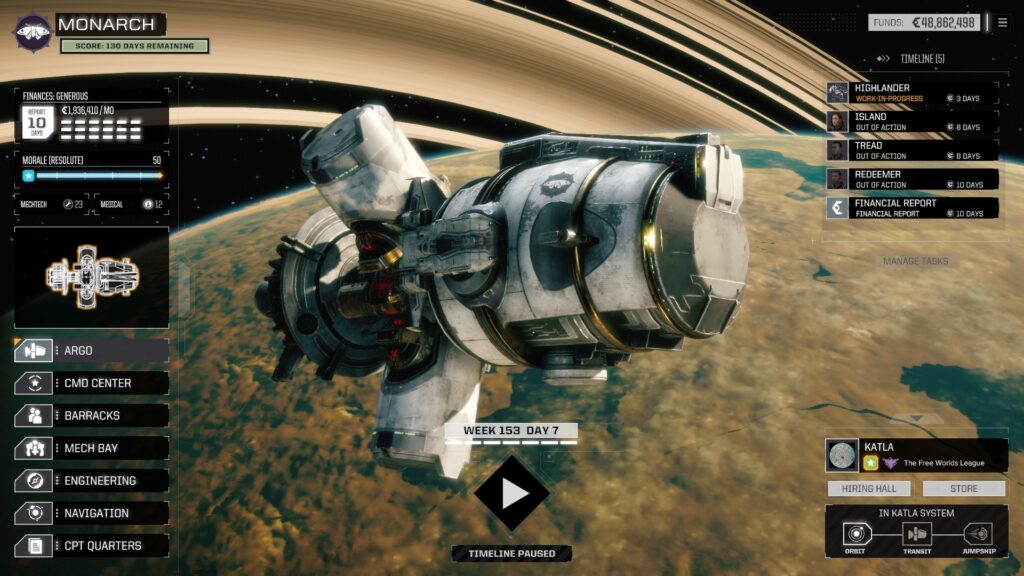
It’s just a technological hybrid. I can get behind this.
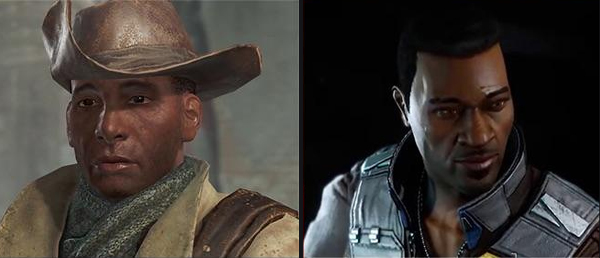
“General, another settlement needs our help! I’ll mark it on your map.”
Allow me a mini-rant…. Darius is positively useless as a spotter and battlefield onlooker.
If he isn’t a reincarnated Preston Garvey sent to plague me for my decision to shun the settlements of Fallout 4, then I can’t discern an Urbanmech from an Overlord.
Missiles slam into my side from offscreen: “I’m detecting enemy reinforcements.”
Me exploding the 4th base defense turret after clearing a mech complement:
“Careful Commander, I’m detecting static defenses – turrets, boss.”
(The clarification of “turrets” to emphasize doubt in my situational awareness is the kicker.)
From Wikipedia: “The [Executive Officer] is typically responsible for the management of day-to-day activities, freeing the commander to concentrate on strategy and planning the unit’s next move. ”
I hire the crew, train them, settle personal disputes, connect to Comstar’s MRB, choose missions, negotiate salvage rights, walk between pre-set nav markers, blow up the opposition, pick the salvage, sell inventory, customize our arsenal, and direct other staff members towards goals for their own personal work!
What is that you do again Darius, besides calmly heckling me one turn after it’d be useful?
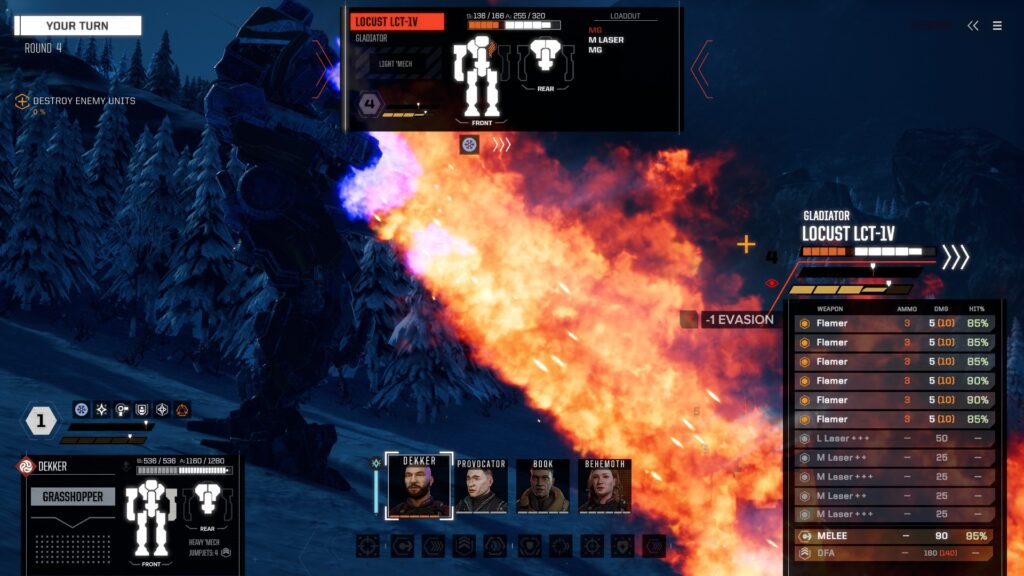
Ha! Flamed you good, Darius. Now go resume the one useful thing I’m forgetting you do.
What I Liked: I loved the sound effects and inspirational musical scores. I loved the tone, the game’s structure, the risk and permanency of combat. There were unexpectedly-massive battles of 8 vs 12 during career mode and I got to meet a lot of famous personalities and interact in lore-meaningful scenarios and campaigns. The morale system with pilot abilities and the consolidated phases with a weighted scale for turn order works incredibly well and helps balance the Grognard tabletop crunch with automation to keep the kids interested. Customizing mechs is always a blast and the Aurigan Coalition sourcebook is an excellent tie-in. The various play modes and min-maxing opportunities are well-rounded and take good care in not power-leveling the player too early to cheapen the thrill. The idea of being an actual pirate and perusing black market appeals heavily to me though I never chose that route in lieu of preserving factional reputation. The amount of mech chassis and variants was great, as was the idea of allowing “support” weapons to fire during melee attacks. I enjoyed the cast of characters despite the bridge crew needing a bit more development and dialogue options – though the randomized events went a long way to appreciating my coworkers. I enjoyed the color palettes and atmospheric effects even if the overall aesthetic was a bit blocky and digitally modular.
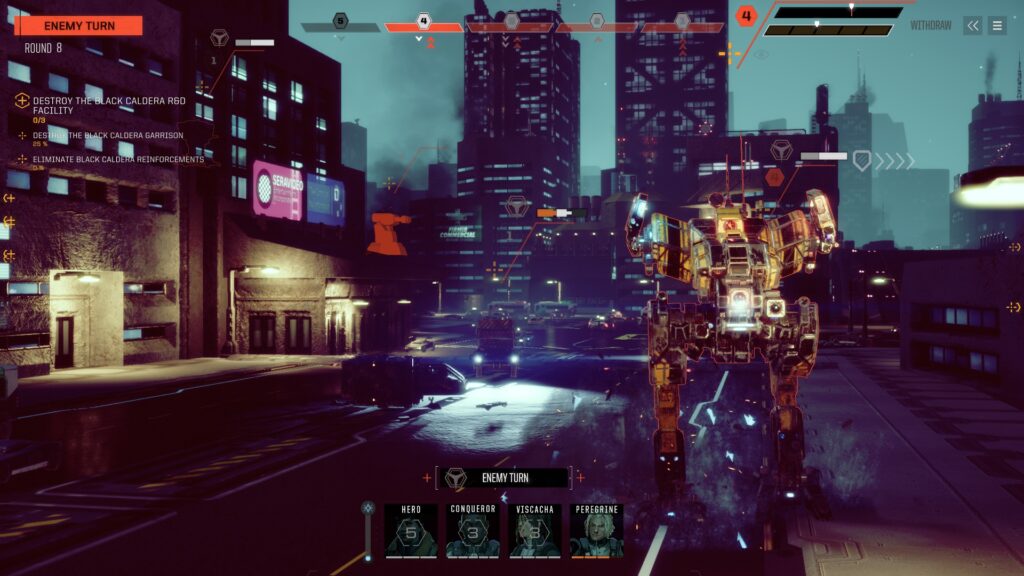
“Shit, I’m being pulled over! Be cool, be cool. You haven’t done anything wrong….“
What I Disliked: I hated selling parts, equipment, and salvage on the market because I never got fair rates. I hate the ideas of retconning an entire faction into an area of space that has been on maps for the last 35 years. The use of anachronistic technology (for fun’s sake) irked me a bit but the broken implementation of ECM made me a God among men and the audio/visual issues associated with it are unacceptable. I hated Darius’s “help”. Career mode dictates how to gain career points but doesn’t reveal details such as what mechs need to be obtained, what map nodes you’ve been to, or reputation level when you’re allied. (It also doesn’t care much about C-Bills, which is the primary reason for being a merc.) There aren’t many incentives to not fielding assault mechs all the time. Pilot portraits and their sound bytes are awful. The game is burdened by heavy and frequent load times and inane delays to management. Past a point, inventory is a pain to navigate. The UI needs polish. There are a limited number of deployment maps and I’m confused why there isn’t a procedural option. My insubordinate crew running their mouths in front of clients is not a fun plot wrinkle. Escort missions are expectantly finicky. The enemy AI compensates with numbers and equipment but it’s still well below a human opponent.
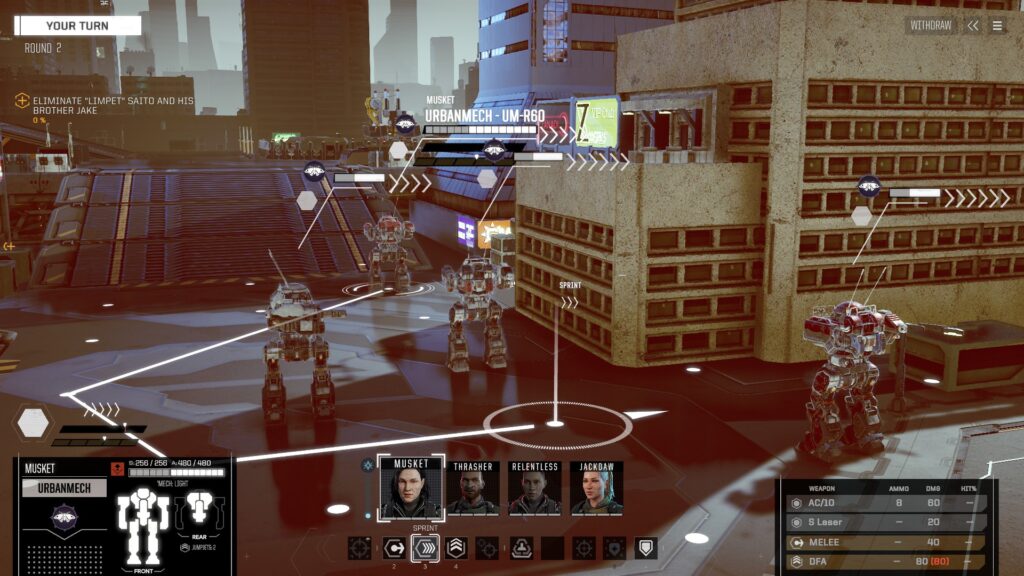
“I suppose you’re wondering why I’ve gathered you all here today.Has anyone given much thought to moving to the suburbs or visiting the countryside?”
Glitches Experienced:
From Day 1, I experienced a myriad of issues that improved as patches were released.
- The game crashed once while I was loading a save during battle – another just after a mission on Ironman Mode…. necessitating I cheat to restore a campaign.
- The map’s terrain dots disappeared once.
- I killed a mech and it remained standing and interactive with my mouse. I had to abort the mission.
- The armor locations chart for mechs didn’t always display when selecting a target. I found this to be a frequent problem solved by hitting the Tab key a few times.
- Twice, I found that the mission difficulty had changed en route to a planet.
- A particular defense mission against vehicles was so imbalanced it might as well be a glitch. I’m no slouch but had to restart 20 times to RNGesus my way through.
- The dramatic viewport pans often failed to track weapons properly or display the damage dealt. Mechs occasionally outpaced the chase cam.
- The last car in a convoy would frequently stop dead in its tracks unless a mech stood one or two spaces away. This infuriating quirk compounded the existing pathfinding weirdness and prevented escort missions from finishing a turn or two earlier, giving the enemy ample time to destroy my wards.
- ECM bubbles rendered mechs as radioactive purple outlines a few times.
Auditory explosions often occurred when the viewport traveled through the bubble.
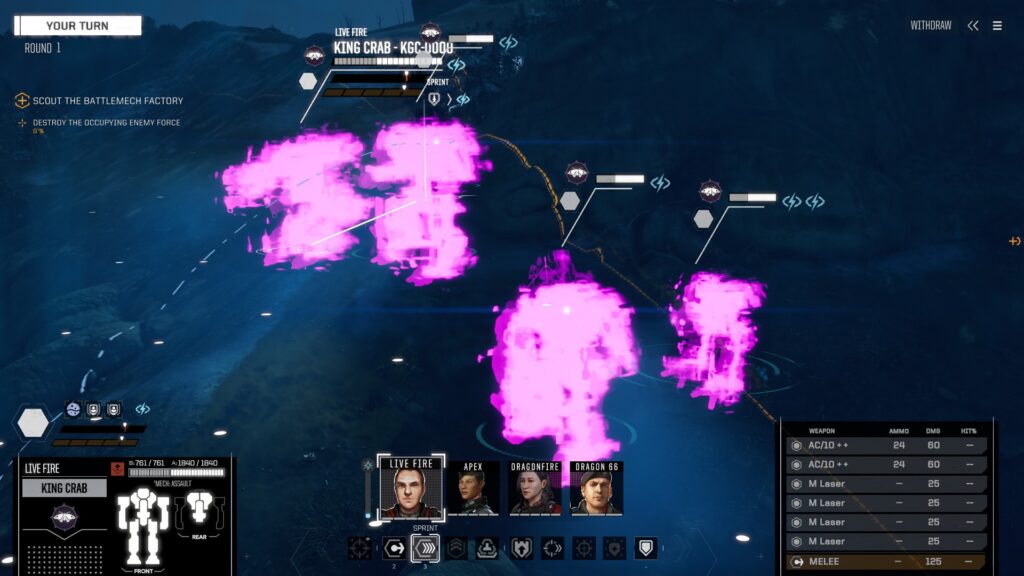
ECM is so overpowered. I mean, how could the enemy even dream of hitting a lance that phase-shifted into the rave dimension?
Hours I Played: 562; Story Mode, 3 Careers, and some Roguetech (a popular mod suite)
My Personal Reaction: I’m as fanatical about Battletech as Blakists are about nuclear weapons and pajama parties. That doesn’t mean I’m not to be trusted for an objective breakdown of the legitimacy of this game – on the contrary, I have to keep myself from being too harsh. (Much of the content of this article was previously adapted and sent to the forums as constructive criticism.)
Merc campaigns are a popular way to experience the universe and this game does an exceptional job of capturing a multi-faceted, thoughtful approach to the intricacies of the universe with as few words as possible. The exhilaration of shooting weapons is offset by the fragility (and expense) at fielding these destructive machines and balancing the budget becomes a feat almost as dreaded as the horrors of war. I enjoyed my playthroughs almost as much as my weekly tabletop meets that existed before the plague times arrived.
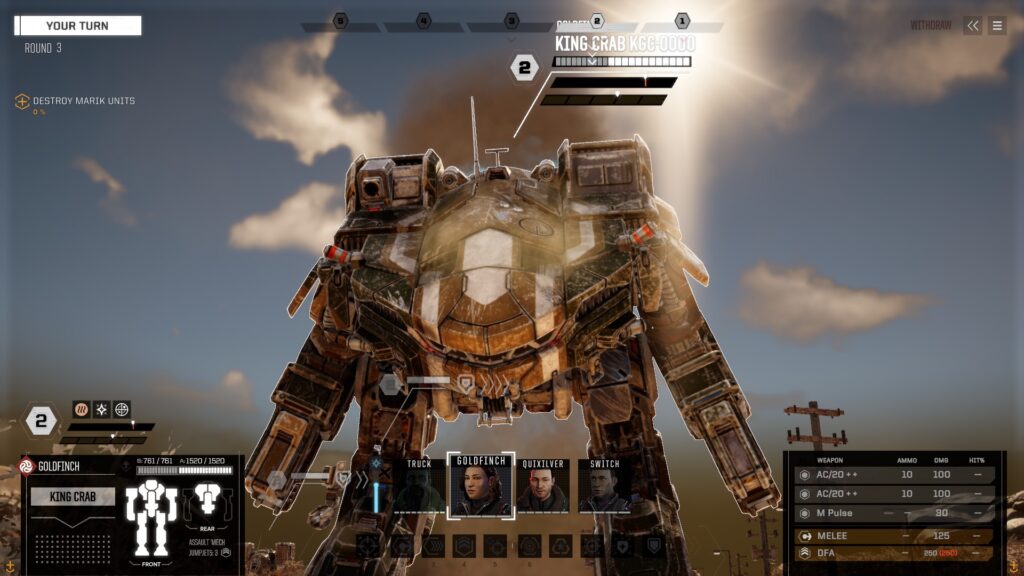
Give ’em the clamps!
Noob Tips:
- Play the campaign first to learn the ropes and lore.
- Repair/modify mechs while in transit.
- Get the evasive attribute bonuses for mechwarriors.
- Try to make all shots into the rear or a single side of a target.
- Look for sides of the enemy that have ammo and fire there.
- Step on vehicles. There is a bonus modifier.
- Fire missiles at turrets. They have only one hit location.
- Run into water to cool down and trees for cover. Don’t stand still.
- Put ammo in your legs and allocate full armor.
- The medium laser is your friend. Great weight, damage, and no ammo.
- Aim for 50% heat efficiency on designs.
- Don’t jump unless you have to, due to heat concerns.
- Keep your mechs together but not adjacent to be hit by stray shots.
- Don’t be afraid to withdraw from the map or to eject a pilot.
- There is a yellow box around the map. Keep your back to the edge.
Depth and Replayability: High Depth, High Replayability
Suggested Value: $40, and the DLC is worth about $10 each
Where to Buy: GOG, Steam, Paradox, Humble Bundle
Subjective Categorical Ranking:
(Platform capabilities are considered for Graphics and Sound)
—————————————————————————————
| poor || bad || average || good || great |
Fun Factor |███████████████████
Unique Gameplay |████████████████████████
Controls & UI |███████████████
Story & Lore |████████████████████████
Graphics & Style |███████████████████
Sound & Music |████████████████████████
————————————————————————————— 
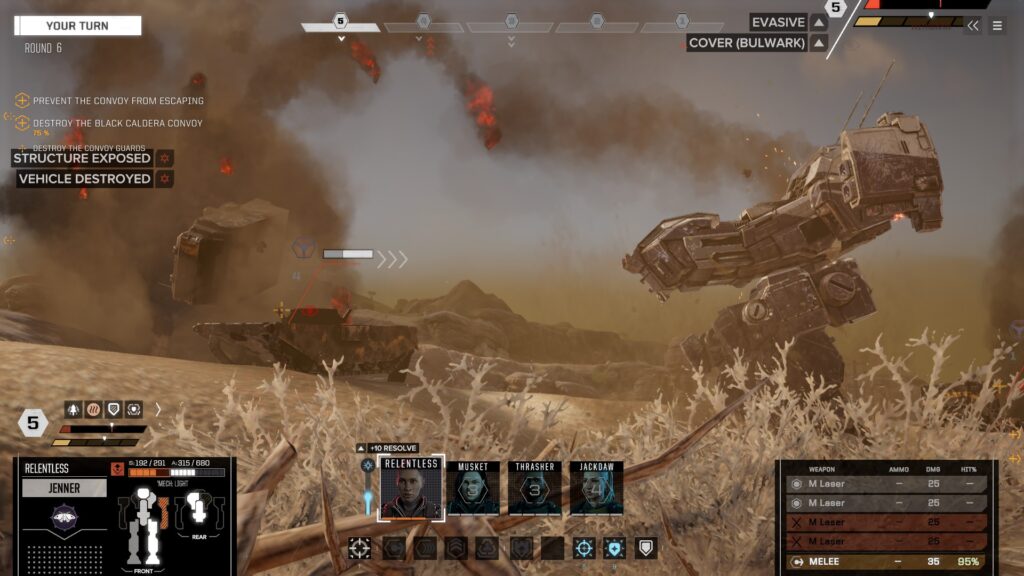
“Rule of cool”: Tanks with legs are inherently better, jackass.
